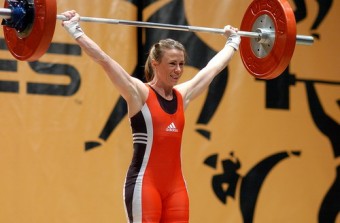Muscle Does Not Turn to Fat if You Stop Exercising
 Myth: Muscle turns to fat when you stop exercising.
Myth: Muscle turns to fat when you stop exercising.
Muscles and fats are made up of very different types of cells that have completely different functions. Skeletal muscles get larger when a person exercises primarily from hypertrophy; in other words, the person isn’t gaining more muscle cells (which would be hyperplasia), rather, the ones they have are just getting bigger, with more filaments and the like being developed within the cells to accommodate the more challenging demand on them.
After a person quits exercising, the muscle cells aren’t going away and somehow managing to morph into fat cells; rather, they are simply shrinking. This allows the body to conserve energy when a person’s daily activities don’t require as much muscle mass; muscle cells take quite a bit of energy to maintain (resting caloric usage of 13 Calories per kilogram per day).
The myth that muscles turn to fat when a person stops exercising probably stems from the fact that people who body build or otherwise exercise quite a bit, who then stop exercising, tend to start looking a little squishy around the edges. There are a few different things that contribute to this, but primarily, it all comes down to caloric intake.
Specifically, people who exercise regularly tend to accustom themselves to eating quite a bit more food than people who maintain a relatively healthy body weight without exercising. Once they stop exercising though, they instantly lose the need for the calories used during their workouts, which is often quite significant.
It gets worse though. Over time, as their body loses muscle mass, their body needs significantly fewer calories even when they aren’t working out. As noted before, resting skeletal muscle cells burn approximately 13 Calories per kilogram per day or around 6 Calories per pounds per day. So they’ll even see quite a difference there while they’re just sitting around doing nothing.
So bottom line, people who exercise regularly who suddenly stop, tend to gain fat quickly because they don’t adjust their food intake to compensate for their decreased caloric needs, not because muscle cells are somehow turning into fat cells.
Bonus Facts:
- There are three main types of muscle cells. The first is smooth muscle, which lines the walls of certain blood vessels and the walls of the esophagus, uterus, stomach, urethra, bladder, and intestines, among other places; this type of muscle is considered involuntary. The second type is cardiac muscle, which is also involuntary and is only found in the heart. The third type is skeletal muscle, which closely resembles cardiac muscle cells and is what most people think of when they think of muscles. Skeletal muscles are attached to tendons which in turn are attached to bones. Cardiac muscle cells tend to be connected in irregular angles, which are called intercalated discs. Skeletal muscle cells, on the other hand, tend to be arranged in parallel bundles.
- Within the types of muscle fibers that we can consciously control, there are slow twitch and fast twitch types. Slow twitch muscle cells are much weaker than fast twitch muscle cells, but they are designed for endurance. Fast twitch muscle cells are relatively strong compared to their slow twitch counterparts, but by virtue of their design, have very little staying power.
- How muscle cells work is as follows: they contain microscopic filaments with even smaller fibers attached to these filaments. When electricity is carried into the muscle from the outer membrane, the fibers from the filaments hook onto fibers from other filaments and push against each other, thus causing the contraction.
- Muscle soreness after workouts, generally appearing the next day, is not caused by lactic acid, as was once thought. Rather, it is caused by tiny tears in the muscle fibers themselves.
- Muscles are approximately 18-26% efficient in terms of the total metabolic cost vs. the actual mechanical work done.
- On average, 42% of an adult man’s body mass is made up of skeletal muscle. For women, that number drops to 36% on average.
- As noted, skeletal muscles consume about 13 Calories per kilogram per day. So, if you weigh approximately 81 kg (180 pounds) and are a man, your skeletal muscles will burn around 442 Calories per day when you are just sit around all day [(81 kg*.42)*13 Calories/kg]. If you are an average female at that same mass, you’ll burn about 379 Calories from your at rest skeletal muscles per day.
- Fat cells will burn around 4.5 Calories per kilogram or approximately 1/3 what skeletal muscle cells will burn. How much of your body mass is made up of fat cells varies greatly from person to person, but you can use a body fat test to get that number and then easily figure out how many Calories your fat cells burn per day. ((BodyFatPercentage * weight in kg)*4.5 Calories/kg)
- Bone cells burn about 2.3 Calories per kilogram. If you are a man, on average about 15% of your body mass is made up of bone. For women, that number is around 12%.
| Share the Knowledge! |
|





what if you stop working out and the fat turns squishy then you start working out again. is it harder to loose the weight and turn it into muscle again?
“Bonus Fact … Skeletal muscles are attached to ligaments which in turn are attached to bones”
Muscles are attached to tendons which in turn are attached to bones. Ligaments connect bones to each other.
@Gerald Fon: Yep, thanks for catching that! You know, a few hundred thousand people have read this article and you’re the first to notice that mistake.
Good read,
How about if one stops workingout and does adhere to lowering their Calorie maintenance level? Does the fat they already have just readjust to fill in the space the muscle initially occupied?